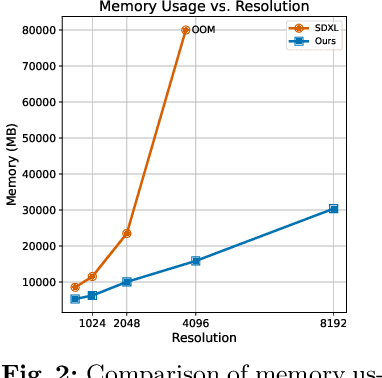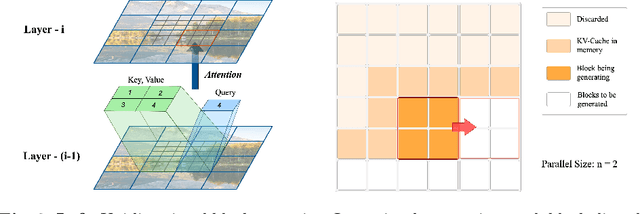Heyang Jiang
PrismLayers: Open Data for High-Quality Multi-Layer Transparent Image Generative Models
May 28, 2025Abstract:Generating high-quality, multi-layer transparent images from text prompts can unlock a new level of creative control, allowing users to edit each layer as effortlessly as editing text outputs from LLMs. However, the development of multi-layer generative models lags behind that of conventional text-to-image models due to the absence of a large, high-quality corpus of multi-layer transparent data. In this paper, we address this fundamental challenge by: (i) releasing the first open, ultra-high-fidelity PrismLayers (PrismLayersPro) dataset of 200K (20K) multilayer transparent images with accurate alpha mattes, (ii) introducing a trainingfree synthesis pipeline that generates such data on demand using off-the-shelf diffusion models, and (iii) delivering a strong, open-source multi-layer generation model, ART+, which matches the aesthetics of modern text-to-image generation models. The key technical contributions include: LayerFLUX, which excels at generating high-quality single transparent layers with accurate alpha mattes, and MultiLayerFLUX, which composes multiple LayerFLUX outputs into complete images, guided by human-annotated semantic layout. To ensure higher quality, we apply a rigorous filtering stage to remove artifacts and semantic mismatches, followed by human selection. Fine-tuning the state-of-the-art ART model on our synthetic PrismLayersPro yields ART+, which outperforms the original ART in 60% of head-to-head user study comparisons and even matches the visual quality of images generated by the FLUX.1-[dev] model. We anticipate that our work will establish a solid dataset foundation for the multi-layer transparent image generation task, enabling research and applications that require precise, editable, and visually compelling layered imagery.
Immiscible Diffusion: Accelerating Diffusion Training with Noise Assignment
Jun 18, 2024Abstract:In this paper, we point out suboptimal noise-data mapping leads to slow training of diffusion models. During diffusion training, current methods diffuse each image across the entire noise space, resulting in a mixture of all images at every point in the noise layer. We emphasize that this random mixture of noise-data mapping complicates the optimization of the denoising function in diffusion models. Drawing inspiration from the immiscible phenomenon in physics, we propose Immiscible Diffusion, a simple and effective method to improve the random mixture of noise-data mapping. In physics, miscibility can vary according to various intermolecular forces. Thus, immiscibility means that the mixing of the molecular sources is distinguishable. Inspired by this, we propose an assignment-then-diffusion training strategy. Specifically, prior to diffusing the image data into noise, we assign diffusion target noise for the image data by minimizing the total image-noise pair distance in a mini-batch. The assignment functions analogously to external forces to separate the diffuse-able areas of images, thus mitigating the inherent difficulties in diffusion training. Our approach is remarkably simple, requiring only one line of code to restrict the diffuse-able area for each image while preserving the Gaussian distribution of noise. This ensures that each image is projected only to nearby noise. To address the high complexity of the assignment algorithm, we employ a quantized-assignment method to reduce the computational overhead to a negligible level. Experiments demonstrate that our method achieve up to 3x faster training for consistency models and DDIM on the CIFAR dataset, and up to 1.3x faster on CelebA datasets for consistency models. Besides, we conduct thorough analysis about the Immiscible Diffusion, which sheds lights on how it improves diffusion training speed while improving the fidelity.
Inf-DiT: Upsampling Any-Resolution Image with Memory-Efficient Diffusion Transformer
May 08, 2024



Abstract:Diffusion models have shown remarkable performance in image generation in recent years. However, due to a quadratic increase in memory during generating ultra-high-resolution images (e.g. 4096*4096), the resolution of generated images is often limited to 1024*1024. In this work. we propose a unidirectional block attention mechanism that can adaptively adjust the memory overhead during the inference process and handle global dependencies. Building on this module, we adopt the DiT structure for upsampling and develop an infinite super-resolution model capable of upsampling images of various shapes and resolutions. Comprehensive experiments show that our model achieves SOTA performance in generating ultra-high-resolution images in both machine and human evaluation. Compared to commonly used UNet structures, our model can save more than 5x memory when generating 4096*4096 images. The project URL is https://github.com/THUDM/Inf-DiT.
 Add to Chrome
Add to Chrome Add to Firefox
Add to Firefox Add to Edge
Add to Edge